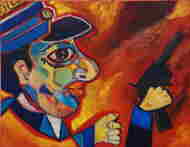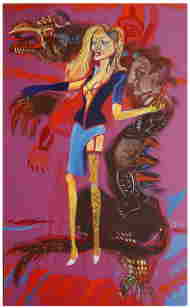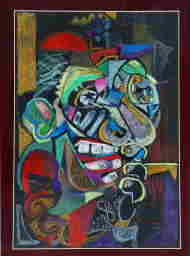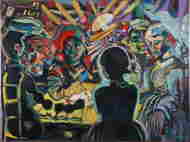|
|
MARINA`S PETRI EXHIBITION
THE NEW – GREEK KARAGIOZIS

Marina Petri outlines the personality of the contemporary Greek with humor but also with a critical glance through the familiar to all of us figure of Karaghiozis. The cunning and crafty protagonist of the theater of shadows. She transforms herself into a busy puppeteer and moves the threads of the artistic game. She creates images, often through the assemblage of different materials, and narrates everyday stories. She enriches the traditional thematic scheme of Karaghiozis with new actions and modernizes her sly hero.
Gone are the days of slavery, poverty and misery! Karaghiozis, in the role of the contemporary Greek, is a free and satisfied man. A member of the European Community, an official citizen of the Continent. Educated, he knows everything just like his co-actor Morfonios from whom he steals in Petri’s work some additional characteristics. For example, he displays the arrogance of the intellectual, he dresses elegantly, he likes to show off and he is just too fond of himself.
Karaghiozis the contemporary Greek, an admirer and victim of fashion, acquires one more European trait, that of the passionate art-lover, an art-collector to be. A regular visitor of the past, he travels with a time machine to the realm of yesterday in order to speak privately –like a successful yuppie- with his favorite artists: the marginal Caravaggio, the lustful Balthus, the exotic Gauguin, the Mediterranean Picasso –a pioneer of cubism along with Braque- the explosive Pollock, to name but a few. He penetrates with boldness into their works and becomes an integral part of them. He constantly transforms himself, reminding the viewer of his hypocritical talent. He adjusts to different environments like a chameleon, he mingles with the protagonists of the paintings, he vanishes to the inhabited spaces of the Rennaissance artists, of the fauves, the nabis, the cubists or the expressionists and provokes the viewer to discover him. He feels equally at ease wherever he goes. A cosmopolitan, well traveled human being, he impresses with the breadth of his acquaintances and knowledge.
 All of a sudden the memories of poverty raise from oblivion. Karaghiozis is then depicted as a guest at the coal-miners / “Patatoe Eaters” of Van Gogh, at the poor and dark environment of a hut that stirs associations, connecting different lands and periods. He immediately recovers, however, from the shock of the traumatic memory of the Ottoman sovereignty and from the complex of inferiority he once felt. He is “Victorious”, the Greek National Football Team won the World Champion. Hellas! He belongs to the West, to a civilization that ancient Greece bore. He may, as most researchers say, have entered our country from Constantinople at the end of the 19th century, yet Petri’ s Karaghiozis is convinced that his roots can be also found elsewhere: in the obscene protagonists of Aristophanes and in the Byzantine theatrical type of Ptohoprodromos.
All of a sudden the memories of poverty raise from oblivion. Karaghiozis is then depicted as a guest at the coal-miners / “Patatoe Eaters” of Van Gogh, at the poor and dark environment of a hut that stirs associations, connecting different lands and periods. He immediately recovers, however, from the shock of the traumatic memory of the Ottoman sovereignty and from the complex of inferiority he once felt. He is “Victorious”, the Greek National Football Team won the World Champion. Hellas! He belongs to the West, to a civilization that ancient Greece bore. He may, as most researchers say, have entered our country from Constantinople at the end of the 19th century, yet Petri’ s Karaghiozis is convinced that his roots can be also found elsewhere: in the obscene protagonists of Aristophanes and in the Byzantine theatrical type of Ptohoprodromos.
A fanatic patriot, he is particularly proud of antiquity and the Byzantium. He admires the linearity of the ancient vases, the clear contours that form the shapes and remind him of his morphology. He applauds the painters Tsarouhis, Engonopoulos and Ghikas who first observed and wrote about this similarity, connecting him with the Greek cultural heritage. He absolutely agrees with them in one more important point: that his multi-angled, naively painted scenic elements are related to the Byzantine representation of space which, in turn, presages the globular perception of the fractured image of the cubists. He himself has to make an additional wise remark. He believes that it is the Greek light -first praised by Periklis Giannopoulos, the distinguished intellectual from the city of Patras-, that breaks up and fragments the form, creating a seemingly cubist structure of the exterior world.
As a true Greek, Karaghiozis feels he is first! A worthy successor of Herodotus, Thales, Pythagoras, Socrates, Heraclitus and so many others. The latter’s philosophy has greatly influenced him, that is why he perpetually changes while combining in his temperament the extreme opposites: the traits of the comic and the tragic hero. Funny, but at the same time a smart aleck and a know-all, he repeatedly overcomes the limits and becomes ridiculous, a pitiable vagabond, wandering around aimlessly, shifting opportunistically according to the wind.
 Petri’s Karaghiozis “Votes with Conviction” PASOK but also supports Nea Dimokratia while having the Leftists in his heart. He struts and takes pride in having succeeded to incarnate the popular Greek conscience. He appears on baking-pans, on wooden triptychs originally made for religious icons or on stools, transforming the functional objects into art-pieces, in order to remind the public of his close relation with the national popular tradition. The artistic compositions are frequently enriched with words or phrases, hints that serve to de-codify the narration. They are often the titles of the works themselves, deliberately written in a hurry, in bad handwriting, in a sloppy manner to remind one of the hand-made signs of old Greek shops or the naif advertisements made for the puppeteers’ shows.
Petri’s Karaghiozis “Votes with Conviction” PASOK but also supports Nea Dimokratia while having the Leftists in his heart. He struts and takes pride in having succeeded to incarnate the popular Greek conscience. He appears on baking-pans, on wooden triptychs originally made for religious icons or on stools, transforming the functional objects into art-pieces, in order to remind the public of his close relation with the national popular tradition. The artistic compositions are frequently enriched with words or phrases, hints that serve to de-codify the narration. They are often the titles of the works themselves, deliberately written in a hurry, in bad handwriting, in a sloppy manner to remind one of the hand-made signs of old Greek shops or the naif advertisements made for the puppeteers’ shows.
The morphology of the work is consistent with its conceptual dimension. The prevailing visual frenzy reflects the confusion of Karaghiozis’ idiosyncrasy. The grotesque exaggeration of the heavily decorated theatrical scene is transferred to the works in various ways. The paintings, made out of pastels and inks, deliberately intermingle various styles, heterogeneous cross-time references and different times. The unskillful little angels of the Venetian icons and the elaborate angels of Raphael become co-protagonists of the popular hero. At other times, co-protagonists are the wild beast and popular pop stars Anna Vissi or Sakis Rouvas, dressed up as a Dionysian Caravaggio. There is no doubt that the ex-miserable humpback has been transformed into a modern, plump, global citizen with a high social provirtual. He visits Mykonos, the birth place of Petri where she lives long periods of time. Overjoyed, he wanders around the port with the expensive yachts brandishing his sunglasses that reflect the latest fashion. Another time he dresses up as an extra elegant groom going to meet Karaghiozena-the bride to be with a rich bouquet of flowers in his hand. We even meet him in fashion dressing-rooms, a tireless researcher of the latest tendencies in designer clothes.
 A large series of works emphasizes his existential chaos through the use of extreme oppositions. Fancy wrapping papers with different qualities and textures, metal papers that reflect the viewer’s idol, beads that shine, multicolored photographs from wide circulation magazines, decalcomania, wrinkled oil papers, and paper laces for serving trays, intermingle to compose the deliberately confusing visual image. These compositions are frequently entrapped in golden wood-carved frames of another era. The heavy frames form part of the work, they contribute to the exaggerated look of the artistic ensemble, and they provoke an additional regression back and forward in time. The noisy result expresses Karaghiozis’ spirit.
A large series of works emphasizes his existential chaos through the use of extreme oppositions. Fancy wrapping papers with different qualities and textures, metal papers that reflect the viewer’s idol, beads that shine, multicolored photographs from wide circulation magazines, decalcomania, wrinkled oil papers, and paper laces for serving trays, intermingle to compose the deliberately confusing visual image. These compositions are frequently entrapped in golden wood-carved frames of another era. The heavy frames form part of the work, they contribute to the exaggerated look of the artistic ensemble, and they provoke an additional regression back and forward in time. The noisy result expresses Karaghiozis’ spirit.
For the newly rich Karaghiozis with the doubtful taste, baroque aesthetics is an indication of great wealth. He follows his own motto “everything that shines is gold” rejecting like a naughty child the popular wisdom which he is supposed to incarnate. A self-seeker, he has decided to enjoy whatever he was deprived of during the Turkish occupation and the Second World War. Let him go astray from the ideological heritage that burdens his lazy shoulders. Big deal, after all we are Greeks!
` Petri cuts into pieces the various papers, delineating specific forms which she then puts together in order to shape the figures and to compose the narration of the image. The technique of “decoupage” refers to the method of construction that puppeteers used and still use to create the lifeless actors of the shadow theater, usually by means of cheap materials. Inventiveness, spontaneity, the search and application of new materials characterize the puppeteers’ methodology and function like a provoking stimulus for Petri. Opposite to the rules set by the international art system –which demand from artists to be subservient to each time’s trendy aesthetic in order to be incorporated in the international market- Petri lets herself free to communicate in a personal and creative manner. She likes experimenting, as she rightfully believes, with various materials and techniques, she moves independently of current artistic trends. She identifies herself with her hero who also negates stubbornly to follow society’s various “must-do” in order to thrive.
 By discussing with Karaghiozis, she honors in her own way the Greek cultural tradition as well as the artists’ views belonging to the 1930s generation. In a series of drawings with intense references to antiquity and the Byzantium she praises the “Greek Line” which forms the title of an important essay on aesthetics by Periklis Giannopoulos. However, Petri escapes from the various ideologies concerning what is named “Greekness”. She wanders in the universal paths of art, deliberately reproduces in her overall oeuvre different styles – revealing a knowledge of art history– and turns to the past in order to criticize the present. She satirizes with a severe disposition, causticity and with intense humor contemporary Greece as well as the contemporary Greek staging a dialogue with the local and the universal artistic scene. She intermingles in a light manner different realities in a single result, without pomposity.
By discussing with Karaghiozis, she honors in her own way the Greek cultural tradition as well as the artists’ views belonging to the 1930s generation. In a series of drawings with intense references to antiquity and the Byzantium she praises the “Greek Line” which forms the title of an important essay on aesthetics by Periklis Giannopoulos. However, Petri escapes from the various ideologies concerning what is named “Greekness”. She wanders in the universal paths of art, deliberately reproduces in her overall oeuvre different styles – revealing a knowledge of art history– and turns to the past in order to criticize the present. She satirizes with a severe disposition, causticity and with intense humor contemporary Greece as well as the contemporary Greek staging a dialogue with the local and the universal artistic scene. She intermingles in a light manner different realities in a single result, without pomposity.
Sokratous 179, Old town
Tel. 6944171652, 6972893818
Ask for the friendly Michalis |